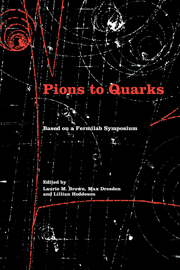Book contents
- Frontmatter
- Contents
- List of contributors
- Foreword by Leon M. Lederman
- Editors' acknowledgments
- Photographs of the symposium
- List of abbreviations
- List of notation
- I Introduction
- II Particle discoveries in cosmic rays
- III High-energy nuclear physics
- IV The new laboratory
- V The strange particles
- VI Weak interactions
- 24 Detection of the neutrino
- 25 Recollections on the establishment of the weak-interaction notion
- 26 Symmetry and conservation laws in particle physics in the fifties
- 27 A connection between the strong and weak interactions
- 28 The weak interactions from 1950 to 1960: a quantitative bibliometric study of the formation of a field
- VII Weak interactions and parity nonconservation
- VIII The particle physics community
- IX Theories of hadrons
- X Personal overviews
- Name index
- Subject index
27 - A connection between the strong and weak interactions
Published online by Cambridge University Press: 07 May 2010
- Frontmatter
- Contents
- List of contributors
- Foreword by Leon M. Lederman
- Editors' acknowledgments
- Photographs of the symposium
- List of abbreviations
- List of notation
- I Introduction
- II Particle discoveries in cosmic rays
- III High-energy nuclear physics
- IV The new laboratory
- V The strange particles
- VI Weak interactions
- 24 Detection of the neutrino
- 25 Recollections on the establishment of the weak-interaction notion
- 26 Symmetry and conservation laws in particle physics in the fifties
- 27 A connection between the strong and weak interactions
- 28 The weak interactions from 1950 to 1960: a quantitative bibliometric study of the formation of a field
- VII Weak interactions and parity nonconservation
- VIII The particle physics community
- IX Theories of hadrons
- X Personal overviews
- Name index
- Subject index
Summary
In the mid-1950s, my colleague Marvin L. Goldberger had acquired a leading position in the burgeoning field of dispersion relations (i.e., the study and exploitation of analyticity properties of scattering amplitudes). To speak of scattering in that era was to speak of strong or perhaps electromagnetic reactions, not weak ones. The weak interactions were, of course, of great and growing interest; but the focus was mainly on decay of weakly unstable particles, rather than on weak scattering reactions. Even for the simplest kind of scattering process (e.g., forward pion–nucleon scattering) there is a continuous physical variable, the energy. It is a well-posed question, therefore, to ask if the amplitude function can be continued into the complex energy plane, to ask what singularities one encounters there, and so forth.
It turned out that these inquiries and others that grew out of them were illuminating and fruitful. In fact, they were among the dominant themes of particle physics throughout much of the 1960s. On the other hand, consider a simple one-body-to-two-body decay reaction (e.g., π → μ + v decay). Here there is no continuous physical variable, no spectrum, just a fixed number for the amplitude – thus, seemingly, no role for analyticity thinking. Maybe this judgment is, in fact, correct. But let us not get ahead of our story; we return to Goldberger. While he was conducting his dispersion-relation pyrotechnics, I was busy pursuing various interests in weak-interaction physics. However, he managed, all the while, to keep a somewhat avuncular eye on my doings, and I tried to keep up with his.
- Type
- Chapter
- Information
- Pions to QuarksParticle Physics in the 1950s, pp. 384 - 389Publisher: Cambridge University PressPrint publication year: 1989
- 1
- Cited by



